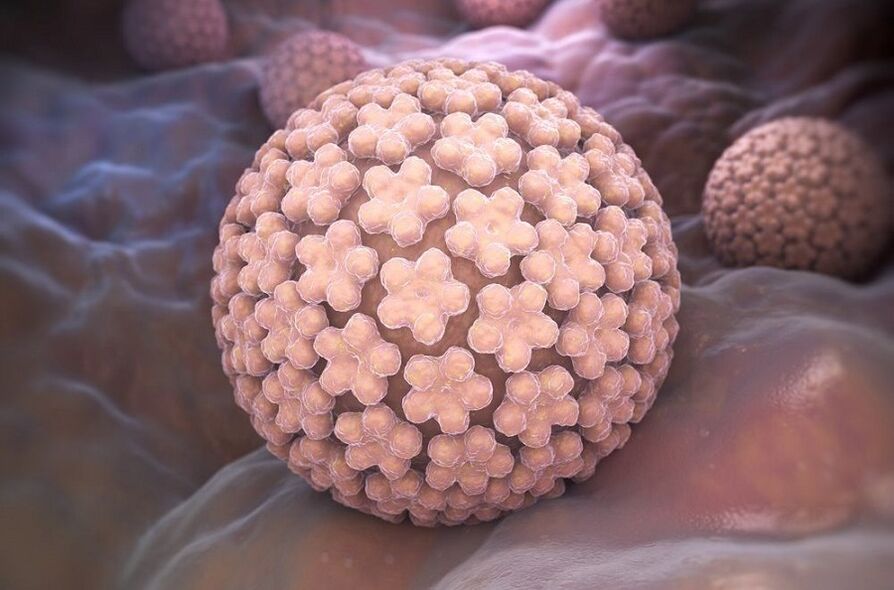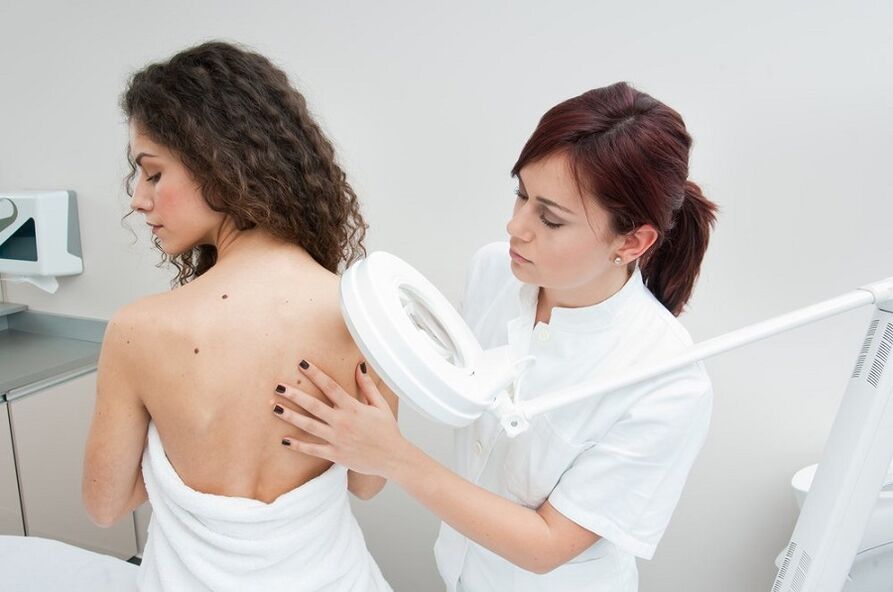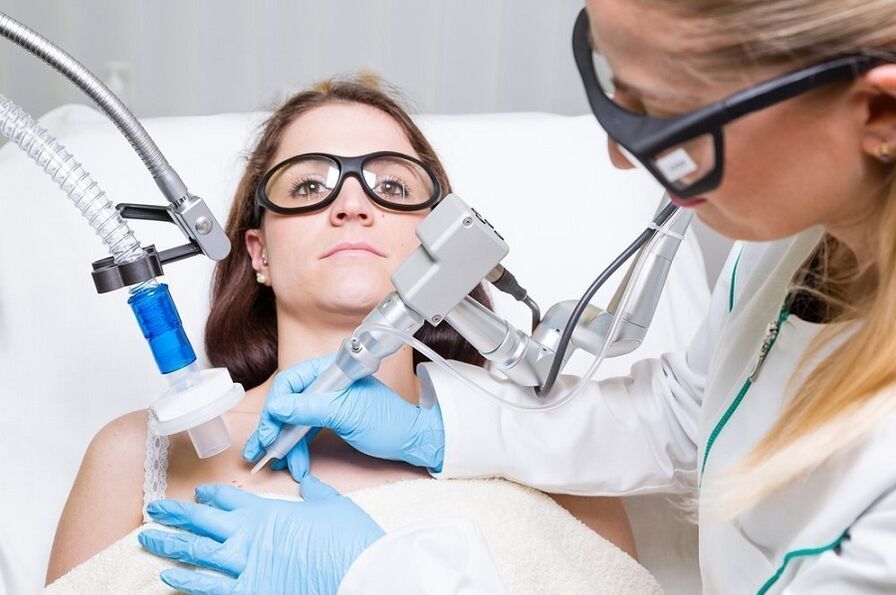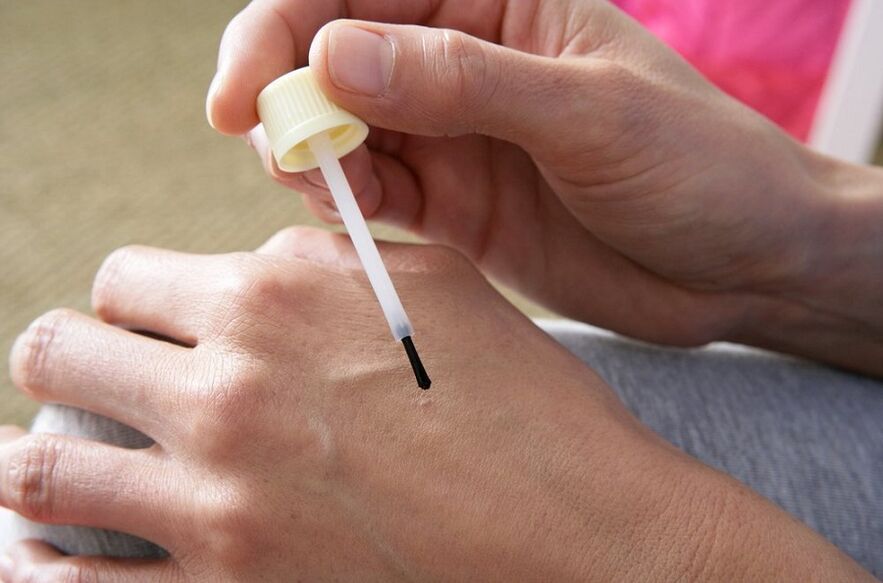Warts are benign tumors of the skin, which are caused by the proliferation of cells in the epidermis and papillary dermis caused by the human papilloma virus. This skin is spread by contact.
Warts: causes, types, diagnosis and treatment
Warts are locally benign formations caused by epidermal hyperplasia. The growth of papilloma and papules are most often due to the activity of viral infections. The main reason for their occurrence is the presence of human papillomavirus (HPV) in the human body. HPV infection occurs through family contact, with the result that the viral flora penetrates the skin or mucous membranes. Skin and mucous membranes suffer various injuries and weaken immunity, which increases the risk of infection.
According to statistics, more than 60% of the population are carriers of HPV. At the same time, symptomatic HPV will not show up even in a lifetime. Warts, many of which are called papillomas, only appear on the skin and mucous membranes when there are favorable factors.
There are many types of warts whose appearance is caused by one virus or another. Each type of skin injury can be located on the skin or mucous membranes. It is not always possible to eliminate the virus from the body.
Warts on the legs, arms, and other parts of the body in adults
Men and women are equally susceptible to human papillomavirus. Therefore, there are neoplasms such as warts on the skin and mucous membranes. Through the usual handshake or the use of general hygiene products, as well as during sexual intercourse, the virus may penetrate the body. Once in the human body, the virus enters the squamous epithelium and actively multiplies in it. The incubation period of HPV ranges from one month to one and a half months to six months or longer.
Warts on the female face, genitals, and other parts of the body

Women's warts can appear on any part of the body at any time in their lives. They can vary in shape, color, and size, ranging from small flat warts on a white surface to dark genital warts on the mucous membrane of the genital organs. It is worth noting that, according to the results of the study, condyloma acuminatum can lead to the development of cervical cancer. In addition, the official confirmation also confirmed the relationship between warts, which are the external manifestations of human papillomavirus and are related to an increased risk of breast cancer.
Papilloma and warts in men
Organisms with strong sexual ability are generally less susceptible to virus infection and active reproduction, especially the appearance of papilloma and warts. Only the sharp decline in immunity caused by various diseases can cause the appearance of benign structures on men's skin and mucous membranes. It should be noted that papillomas and warts on the male genitalia may be located in the area of the coronal sulcus and frenulum, sometimes in the head or body area of the penis, on the quilt at the entrance of the urethra, and directly on it. Mucosa, in the perianal area.
What are the types of warts in children?

People of any age are prone to warts. However, warts are most common in children and adolescents. The reason may be various papilloma viruses. Infections of children's bodies usually occur through contact and family means. Children are more likely to communicate closely with other babies in large groups and easily "catch" various viruses with each other. In addition, during intrauterine development or childbirth, children may be infected with the mother’s papillomavirus.
Warts: Causes of appearance
Many factors can cause warts to appear. As mentioned earlier, the spread of papilloma virus occurs through close contact with an infected person or their belongings. In addition, viral vectors without any external manifestations can also be used as the source of infection. Similarly, self-vaccination or in other words self-infection is not excluded. Therefore, after shaving and peeling, warts will appear on the face and neck. The same goes for papillomas and warts on the legs, chin, and armpits. Various lesions on the skin only increase the risk of HPV infection. This usually happens in swimming pools, gyms and saunas.
Stimulus

The virus that causes the formation of warts is unlikely to penetrate the body of a healthy person with strong immunity. The risk of infection can be increased in the following ways:
- Damage to skin and mucous membranes.
If it is present, contact with an infected person's appearance or objects with the virus on the surface may cause infection. HPV can stay in the environment for about 2-3 hours. During this time, the possibility of someone being infected with it is very high. Injuries (wounds, cuts, abrasions), sweating and the resulting moisture in the skin will only increase the damage to the skin.
- High humidity and warmth.
This irritation factor is most related to the appearance of leg warts. Uncomfortable parka shoes can cause excessive sweating, calluses and skin damage, and can lead to epithelial growth, such as warts on the feet.
- The immune system is weakened.
Even if there is a virus in the body, the appearance of warts is far from being observed. A person can carry the virus for decades without knowing it. With strong immunity, the body will continuously suppress the virus, thereby preventing its reproduction. Once the immune system is weakened, the virus is immediately activated, accompanied by external manifestations.
Seborrheic warts
With age, the human body undergoes major changes, which are not only reflected in appearance, but also reflected in health. Therefore, violation of epidermal basal cell distribution can lead to benign formation, called seborrheic warts. In other words, this type of wart is called old age. Recognizing senile warts by their characteristic appearance is very simple:
- They are represented by pimples or patches that protrude on the surface of the skin.
- The tumor is round or oval;
- They are usually located on the skin of enclosed areas of the body and on the face and scalp;
- The color of the wart can be yellowish brown, sometimes even black.
- The size of the strata can vary from 0. 5 to 4 cm.
The boundaries of seborrheic warts are clear. They protrude slightly above the skin and may flatten slightly.
If you have these warts on your hands, face, body or head, you should see a doctor. In order to determine the most effective and safest treatment and removal strategy, it is necessary to perform a differential diagnosis to distinguish seborrheic warts from:
- Pigmented nevus.
These tumors are benign. Like seborrheic warts, pigmented moles are yellow-brown or dark, closer to black. Sometimes the papillary surface of the mole is covered by hair. Their size can be different. In shape, this type of tumor can appear as huge plaques or flat papules with smooth surfaces.
- Dermofibroma.
This benign formation is formed by the skin and connective tissue. In appearance, dermatofibromas are similar to moles and warts. The surface of the formation can be both smooth and keratinized. Their shape is round. The dermatofibroma is partly located in the upper layer of the skin and partly protrudes from the skin surface. The most common is to find a single tumor. Their colors can be different: from grayish pink to purple. Sometimes dermatofibroma is brown or black. The size of the stratum is about 1 cm.
- Melanoma.
Unlike dermatofibroma and pigmented nevus, melanoma is a malignant tumor. They appear on the site of the mole or nearby tissues. The factors that cause malignant tumors of skin cells are ultraviolet rays and various damages.
Human papillomavirus infection

As mentioned earlier, HPV is the cause of HPV infection. So far, more than one hundred varieties of them are known, and they may affect the human body in one way or another. Each type of virus causes certain types of warts:
- HPV 1-benign formation on the palms and soles of the feet;
- HPV 2-normal (normal);
- HPV 3, 10, 28 and 29-flat tumors;
- HPV 4-plantar warts and vulgar warts;
- HPV 6, 11-Laryngeal papillomatosis and genital warts;
- HPV 5, 8, 9, 12, 14, 15, 17, 19-25, 36, 39, 40-a common manifestation of the virus, which is a kind of epidermal hyperplasia with warts;
- HPV 7-Common warts;
- HPV 13, 32-local hyperplasia of epithelial tissue;
- HPV 16, 18, 31, 33, 35-malignant tumors, such as cancer and genital dysplasia.
In addition, due to weakened immunity, the human body is more susceptible to papillomavirus types 26 and 27. In some cases, HPV 30, 34, 37, and 38 may be the cause of benign and malignant tumors.
It is also worth noting that some types of papilloma are transmitted through family contact, while other types are transmitted through sex.
Types of warts: common, plantar and other, treatment
Quite a lot of papillomavirus variants and other causes of warts lead to different locations and different characteristics. Therefore, there are:
- Common warts, also called rough warts.
They are usually located on the skin of the hand. The color of these growths ranges from flesh to brown.
- Plantar warts.
This formation penetrates deeply into the tissue, causing painful sensations, and is accompanied by capillary thrombosis, which can bleed even with minimal damage. Plantar warts need to be treated by a doctor, not removed by yourself or in a nail salon.
- Flat warts.
Their positioning is usually observed on the skin of the neck, face, chest, knee flexion and forearms.
- Genital warts are more commonly called genital warts.
This formation affects the external reproductive organs and the skin and mucous membranes of the perianal area. They may be located at the entrance of the urethra and then spread proximally.
- Perianal warts.
This structure is most often located in the nearby tissues of the female anus and vagina and external reproductive organs. In men, perianal warts are located on the anus.
- Laryngeal papillomatosis.
This manifestation of the virus mainly occurs in childhood. There may be multiple tumors, which is particularly dangerous to life and can cause obstruction of the respiratory tract.
Anogenital warts
Anogenital warts are benign tumors located on the skin and mucous membranes of the external genital organs and perianal area. All anogenital warts are usually divided into:
- Typical con.
Usually, these warts are located at the entrance of the vagina, the anus and the lining of the foreskin. These tumors may resemble broccoli in shape.
- Pimple warts.
The surface of this tumor is smooth and does not contain a keratinized layer.
- Warts with hyperkeratosis.
Unlike previous warts, the surface of this anogenital formation is covered with keratinized tissue particles. In most cases, hyperkeratosis dysma is located on the outer lobes of the foreskin in men, the body of the penis and scrotum, and the labia majora in women.
- Flat warts.
Formations are represented by spots that protrude slightly above the surface of the skin. They are actually invisible and are not always immediately recognized by people.
Giant con muscle Buschke-Levenshtein

Sarcoma-like condyloma acuminata occurs when HPV 16 virus enters the human body. According to some research results, HPV types 1, 6, 11, 18, 31, 33 that are transmitted through contact and sexually may also cause the appearance of such warts. The second name for this education is the giant condyloma Bushk-Levinstein. The main differences are:
- The size increases rapidly;
- It is possible to receive re-education after treatment;
- Destroy nearby organizations;
- The possibility of squamous cell skin cancer is high.
Young and old people are most susceptible to this type of tumor. In men, the virus is manifested by the appearance of condyloma acuminata on the tissues of the glans penis and foreskin. Sometimes genital warts Buschke-Levenshtein may be located on the outer skin of the shaft of the penis. In women, the stratum is usually located in the perianal, anorectal, and groin areas. Do not rule out their appearance on the face, oral mucosa and other areas of the skin and mucous membranes.
Common warts on fingers and other parts of the body
The most common benign skin lesions are common warts, also called common warts. In appearance, this formation is hard and dry protrusions on the skin. Their surface is not flat. The size is within a few millimeters. In most cases, these warts are located on the fingers and hands and on the face. The color of the tumor is usually gray, yellow-brown or flesh-colored.
Palm-warts on arms and legs
Warts can easily appear on the palms and soles of the feet. They have various shapes and colors, from light yellow to dark brown. These epithelial formations are common in the population. They may be very shallow, mosaic-like in appearance, or very deep (hyperkeratosis).
The treatment of palm and plantar warts is complicated. The dermatologist must rule out lichen planus and verrucous tuberculosis during the full diagnosis.
Flat warts on face

Flat warts are almost always small and have a smooth surface (few scales). In fact, its color is not different from the color of skin, so people often live in this form without even noticing them at all. Usually, this flat epithelial structure appears on the skin throughout the group.
Experts will be able to detect and accurately identify flat warts on the face or, for example, the back of the hand on the first date. Visual inspection is sufficient to enable a competent physician to understand what he is dealing with. If the dermatologist has questions about the presumptive diagnosis, other diagnoses can be assigned, including laboratory tests.
Diagnosis of human papillomavirus infection
The clinical manifestations of warts mainly depend on where they form. Each type of epithelial tumor mentioned above has its own characteristics.
- Common warts are characterized by obvious hyperkeratosis (high rate of stratum corneum cell division and desquamation).
It looks like nodules or dome-shaped papules. These warts mainly appear on the skin of the hands, feet, and elbows where the risk of tissue injury is increased.
- Flat warts have flat vertices, small in size, and no more than 3-4 mm in diameter.
If you see warts in the folds of the skin, the initial diagnosis may be difficult because the pimples or growths may appear as flat warts or common warts.
- Warts on the soles of the feet may be accompanied by painful symptoms because these areas of the body are often traumatized. The center of this epithelial tumor may be slightly sunken.
It is also common for multiple warts on the sole to merge into a single structure and form a specific pattern in a mosaic form.
- For filiform warts, such problems may appear on the facial skin.
They grow fast, so when detected, they will try to be removed as surface defects.
- Similarly, warts can be diagnosed in the oral cavity, and the formation in the oral cavity is usually represented by small whitish or pink nodules.
Usually, in rare cases, this kind of problem will be found when visiting the dentist or during routine physical examinations.
Warts: Treatment

Epithelial tumors in the form of warts can only be treated under the strict supervision of the attending physician. Treatment cannot be general, because each case of the appearance and development of the disease is individual. Therefore, it is not recommended to use suspicious drugs on the advice of friends, advertisements or pharmacists in pharmacies.
So far, there is no specific therapy for human papillomavirus. Therefore, the treatment of warts aims to eliminate the symptoms of viral lesions.
If the patient is diagnosed with condyloma acuminatum, this type of education must require carefully selected treatment methods because of the risk of malignant degeneration.
There are several ways to treat warts, each with its own characteristics. The effectiveness of all treatments is about 70%.
Treatment of warts: external therapy
The treatment of warts is mainly aimed at removing warts. It can be done through physical intervention or medication.
Using external methods, warts are complicatedly treated. The doctor may prescribe cautery and keratolytic drugs. It can be 10% silver nitrate solution, 50% lactic acid solution.
Your doctor may recommend antiviral drugs to treat warts.
Cytotoxic drugs, such as fluorouracil cream, are also topical. It is prescribed for the use of salicylic acid to treat warts and various plasters (40%).
The physical destruction of warts can be accomplished by liquid nitrogen and electrocoagulation. Salicylic acid or trichloroacetic acid, sodium silver solution, sodium hydroxide can be used to chemically destroy the tissue.
Immunotherapy is also used. After the warts are removed, your doctor may prescribe anti-inflammatory drugs.
It is forbidden to remove warts at home

According to most people, traditional medicine can safely treat many diseases. However, this view is wrong, because essential oils and herbal decoctions, infusions and various compresses can only play a supplementary role and should not be used as the main treatment method under any circumstances.
Combined with the effects of drugs, the attending physician can prescribe alternative drugs for celandine, rowan fruit, wormwood, onion, linseed oil, and milkweed.
Do not remove warts at home. Do not pierce or burn education with sharp objects. Only qualified doctors can prescribe an appropriate and safe treatment plan after diagnosing the patient's condition. Be careful not to take your medicine lightly.
Laser wart removal and other methods
Modern medicine uses several surgical techniques to remove warts.
- Electrocoagulation is one of the most mature methods for removing various warts.
Use a coagulator to operate under local anesthesia. The high-frequency current supplied to the steel ring helps to thin the epithelial block and prevent bleeding during and after the operation.
- For extensive skin lesions, surgical resection is recommended.
This operation is performed under local anesthesia, and then cosmetic sutures are applied, which are removed after about 1 week. May leave a slight scar.
- Laser removal of warts is the latest treatment.
The effect of this manipulation can be presented in the form of evaporation or condensation of skin cells. Laser wart removal is quick and absolutely painless because the procedure is performed under local anesthesia. After the wart is removed, a small amount of depression may remain, and the depression will disappear after 12-20 days.
Many medical centers and clinics now provide laser removal services.
- You can also use low temperature to remove warts.
Deep freezing of the tissue can cause its death. This is the method of cryogenic distillation of liquid nitrogen.
Use frozen cotton swabs or swabs coated with cotton swabs for this type of wart removal. In any case, the process is effective and only takes a few minutes.
Apply the applicator (vertically) to the wart and press lightly on it. The time required for epithelial tumor freezing mainly depends on its size. Freezing usually takes 7 to 35 seconds.
It is important to know that any method of removing warts does not guarantee that the problem will not recur. The possibility of reorganization depends on many factors, including the patient’s immune system. According to statistics, more than 20% of patients will relapse after 3-4 months. This is why many doctors prescribe general anti-recurrence treatments as well as surgical removal of warts.
Prevent warts

To at least protect yourself from viral infections and reduce the risk of warts in your body, doctors recommend that you first adopt a healthy lifestyle. It is necessary to continuously and effectively maintain the immune system. Due to constant nervousness, lack of sleep, malnutrition and even lack of vitamins, the immune system will lose its protective function.
The doctor recommends:
- Reject casual sex. It is recommended to have a permanent and healthy partner.
- Observe personal hygiene rules. You should not use other people’s towels, and don’t change your shoes to go to public baths.
- Correctly treat lesions on the skin.
Eating correctly, maintaining an active lifestyle, getting rid of bad habits, getting enough sleep, and reducing tension are also important because all these factors will have a negative impact on the immune system.























